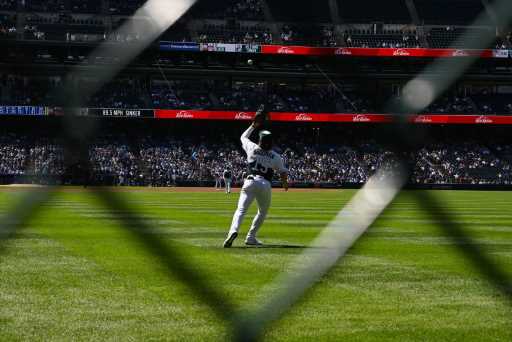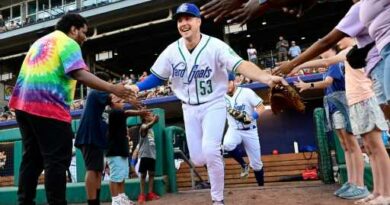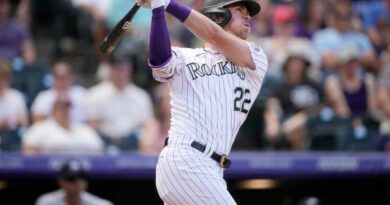Rockies look inward to solve problems. Is Bill Schmidt the answer?
When Bill Schmidt was named the fourth general manager in Rockies history, he inherited a to-do list longer than a Coors Field homer on a hot August night.
Schmidt was tasked with revamping a dysfunctional front office, replenishing a depleted farm system, upgrading an understaffed analytics department and helping shape a winning culture in the clubhouse.
Ever the optimist, Schmidt made an interesting statement at last year’s winter meetings in San Diego.
“We’re not where we need to be. But I use the bamboo theory,” Schmidt said. “There’s a lot of stuff growing underneath that people don’t see, and it’s gonna pop here. When it does, we’re going to be good.”
Ten months later, Rockies fans are still waiting on that pop.
Colorado just lost 100 games for the first time in franchise history, extending its current playoff drought to five seasons. And with few MLB-ready pitchers in the pipeline to shore up what will still be an injury-riddled rotation next summer, it isn’t hard to see that drought extending to six in 2024.
Still, Schmidt believes his team is on the verge of winning, if not next season then in 2025.
There are some within the baseball industry who believe the 64-year-old baseball lifer has the experience, knowledge and connections to turn things around. Agent Joel Wolfe, who represents third baseman Nolan Arenado and several other All-Stars, is among them.
“I think Bill does a really good job, given his resources,” Wolfe said. “He’s a great communicator and a good baseball evaluator.”
During a tense news conference, then-general manager Jeff Bridich and owner Dick Monfort were grilled by local and national media in the wake of a one-sided blockbuster trade that sent Arenado to the St. Louis Cardinals.
Reporters asked Bridich if the trade was the result of the organization’s failure to put a winning product on the field or a feud that had developed between Bridich and Arenado. Or both.
Just two years earlier, Arenado signed an eight-year, $260 million contract extension. But an opt-out clause allowed him to wield leverage over the organization once things went sour.
“Look, if we’re looking to pass blame, you can blame me,” Bridich said. “It’s the job of a GM to create a team that competes and wins as much as humanly possible.”
Three months later, Bridich resigned. Two months after that, assistant GMs Jon Weil and Zach Wilson were gone, too.
In the months leading up to the widely-panned trade, a contentious atmosphere existed inside the walls at 20th and Blake, multiple sources told The Post. Bridich had “become an island onto himself,” one source said, as communication broke down.
But the departures of Bridich, Weil and Wilson did not prompt Monfort and team president Greg Feasel to look for fresh voices. Rather, the club promoted from within to fill key roles.
Danny Montgomery, who’s been with the club since its inception, became vice president and assistant general manager of scouting. Zack Rosenthal, already an assistant GM and assistant general counsel, was promoted to vice president of baseball operations. Chris Forbes, who had served as assistant director of player development for three seasons, was promoted to farm director.
“We needed everybody pulling in the same direction,” Schmidt said. “But we have a lot of good people here.”
So far, however, the new direction has produced the same old results. Since Schmidt was named interim GM, the Rockies’ winning percentage was .418 (188-262) entering the final homestand of this season.
Baltimore rises
The resurgent Baltimore Orioles went through a front-office shakeup of their own, and an even worse run of losses. But the Orioles took a different path than Colorado – they cleaned house.
In November 2018, following a dreadful 115-loss season, the Orioles fired executive vice president of baseball operations Dan Duquette and manager Buck Showalter. Then they hired Mike Elias as executive vice president and general manager. Elias had been the Houston Astros’ assistant general manager and helped rebuild a team that bottomed out from 2011-13 but won its first World Series in 2017.
When Elias came over from Houston, he brought Sig Mejdal with him. Mejdal, a statistical wizard, former NASA engineer and blackjack dealer, was made assistant general manager and vowed to expand the use of analytics. Elias traded away many of the team’s top veterans, including third baseman Manny Machado, second baseman Jonathan Schoop and pitcher Kevin Gausman, in an effort to retool.
Elias also hired former Cubs bench coach Brandon Hyde as manager.
Though Elias hinted that a rebuild would take time, impatient Baltimore fans howled their disapproval when the Orioles lost 108 games in 2019 and 110 in ’21.
“I knew we were rebuilding, but at the same time, man, you’re losing over 100 games,” 62-year-old Orioles fan George Dutrow said during a Rockies-Orioles game at Baltimore’s Camden Yards in late August. “It’s hard, there’s no other way to put it. But as a true Orioles fan, as I consider myself to be, I wanted to stick it out.”
While Elias tore down the roster and then rebuilt it, Hyde set about changing the Orioles’ culture. Asked how he did that, Hyde laughed and replied, “Are you writing a novel?”
The cliff notes version: The Orioles turned a corner in 2022, falling just three games short of the final AL wild-card spot, and are now headed to the playoffs for the first time in seven years.
Analytical approach
There are many different ways to try and win in the majors.
Big market teams such as the Los Angeles Dodgers, New York Mets, New York Yankees and Philadelphia Phillies have the deep pockets necessary to spend big on free agents.
The Tampa Bay Rays pump resources into analytics, employing an MLB-high 44 staffers in their research-and-development department, and have made the playoffs nine times in 16 seasons, despite a $79.2 million payroll that ranks 27th in the majors.
Baltimore, another small fry in the hyper-competitive American League East, has followed a similar plan, focusing its dollars on the minor leagues, scouting and analytics. According to Zack Scott of the consulting firm Four Rings Sports Solutions, the Orioles have 23 staffers in their research-and-development department, the 13th-most in the majors.
When Schmidt took over as GM, Colorado’s analytics department trailed the rest of the league by a wide margin. Almost the entire staff left during the 2020 pandemic, leaving Brittany Haby, now the manager of baseball research, as the last person standing in the department.
The front-office shakeup in 2021 stalled Colorado’s plans to beef up its analytics staff, but Schmidt made it one of his priorities when he became the GM.
“We need to get it back, and, yes, we have lost some people,” Schmidt said. “But analytics are no different than any tool. That’s how I look at analytics, as a tool.”
In fits and starts, the Rockies have slowly built up the department. In the fall of 2022, they hired Scott Van Lenten away from the Washington National to be the head of research and development, and the department grew to a full-time staff of six. Van Lenten, however, was fired six months after he was hired.
Although Colorado’s R&D department has since grown to 11 under director Brian Jones, the team’s video coordinator for 16 seasons, it’s still the second-smallest staff in the majors (Oakland has eight).
“We have plans to continue to grow in the future,” Jones said recently.
Scott believes that, given the mile-high environment where the Rockies play, the franchise’s investment in analytics should be more robust.
“I don’t think you have to have 44 people or even 30 people, like some clubs,” said Scott, who spent 18 seasons with the Boston Red Sox and helped them win four World Series as vice president of R&D and as an assistant general manager. “But I would think, that the science of baseball, or thinking like scientists, could benefit the Rockies more because they are in such a unique environment.”
Testing the “bamboo theory”
Schmidt, for one, thinks conditions are ripe for a turnaround in LoDo.
Unhappy with the club’s injury-riddled, 100-loss season, the former Rockies scouting director vows that the franchise will not sit idle in the coming months.
“We are going to be open to anything this offseason,” he said recently.
The Rockies have big holes to fill, especially on the mound with starters German Marquez and Antonio Senzatela both likely to miss all of 2024 after undergoing Tommy John surgery. But history tells us the Rockies are rarely aggressive during the hot stove season.
It’s difficult to judge exactly what the front office’s philosophy is. The Rockies sat idle at the 2021 and ’22 trade deadlines, holding onto veterans on expiring deals who eventually left via free agency (shortstop Trevor Story and starter Jon Gray) one year, and extending another (closer Daniel Bard) the next.
But Schmidt was much more active this summer, acquiring seven much-needed pitching prospects in exchange for veterans C.J. Cron (first base), Randal Grichuk (outfield), Mike Moustakas (corner infield), Brad Hand (left-handed reliever) and Pierce Johnson (right-handed reliever).
Schmidt clearly likes to extend contracts to Rockies veterans he believes in, such as left-hander Kyle Freeland (five-year, $64.5-million extension signed in April 2022) and third baseman Ryan McMahon (six-year, $70 million deal signed in March 2022).
The Rockies are betting that those big contracts — along with the signing of Kris Bryant before the 2022 season — are money well spent. They’re also betting a corps of raw, talented position players will grow. And, someway, somehow, the Rockies need to cultivate pitching.
Rockies manager Bud Black, who has a solid working relationship with Schmidt, can see a blueprint coming together.
“Behind the scenes, he’s done great work bringing every facet of the baseball operations department together,” Black said. “In the midst of a tough year, he’s maintained consistent leadership, with a clear vision and plan for the coming years.”
Perhaps, but success seems far away, as Freeland made clear after a Rockies’ blowout loss to the Padres in early August.
“We all want to win and we all want to have success and we all want to be in the playoffs playing meaningful baseball,” the lefty said. “Right now, it seems like every time you look down that tunnel, looking for that light, it just keeps getting further and further away.”
Rockies Baseball Organizational Chart
Most of the key baseball decision-makers in the Rockies’ front office have been with the team for many years. A closer look:
Owner/Chairman, CEO — Dick Monfort (26 years)
President/COO — Greg Feasel (28)
Senior VP/General Manager — Bill Schmidt (23)
VP International Scouting and Development — Rolando Fernandez (31)
VP and Assistant GM of Scouting — Danny Montgomery (33)
VP and Assistant GM of Baseball Operations and Assistant General Counsel — Zack Rosenthal (18)
Senior Director, Scouting Operations — Marc Gustafson (30)
Director, Professional Scouting Operations — Sterling Monfort (13)
Director, Player Development — Chris Forbes (16)
Director, Research and Development — Brian Jones (17)
Director, Pitching Operations — Steve Foster (9)
Director, Research and Development — Brian Jones (17)
Manager, Baseball Research — Brittany Haby (6)
Special Assistant to the GM — Vinny Castilla (16)[
Want more Rockies news? Sign up for the Rockies Insider to get all our MLB analysis.
Share this:
- Click to share on Facebook (Opens in new window)
- Click to share on Reddit (Opens in new window)
- Click to share on Twitter (Opens in new window)
- Policies
- Report an Error
- Contact Us
- Submit a News Tip
- 2023
- September
- 28
Source: Read Full Article











